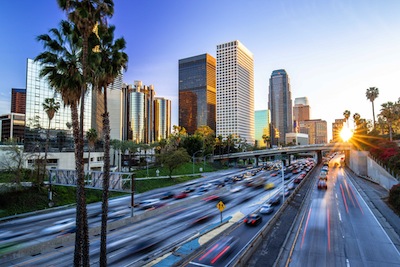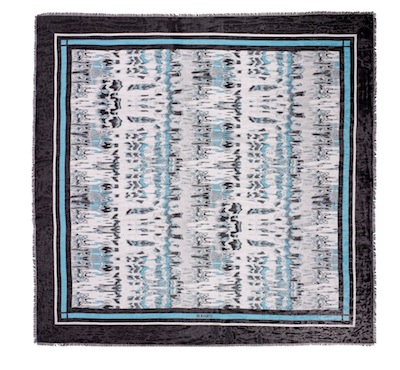While brands acknowledge the importance of digital and consumers begin to search for authentic experiences and services, current market trends suggest that traditional luxury will come full circle, per a new report by the Beverly Hills Conference and Visitors Bureau.
The BHCVB, Beverly Hills, CA’s designated marketing organization, worked with trend forecast agency IN(K) to examine the current landscape of the luxury market and its trends on a global scale. Divided into three chapters, looking at the macroeconomics of top tier international cities, the emergence of digital and ecommerce and luxury values, “The Future of Luxury” report offers insights on the high-net-worth sect’s behavior and attitudes toward the industry.
"Luxury brands can benefit from the findings by learning what the upcoming trends are and how they can adapt their offerings accordingly," said Julie Wagner, CEO of the Beverly Hills Conference & Visitors Bureau, Beverly Hills, CA. "Whilst acknowledging the importance of the digital environment, luxury consumers will seek out more original and authentic experiences that can’t be seen or bought online.
"BHCVB has identified this future trend as Luxury 3.0 where consumers will revert back to concepts with historic origins, such as private members clubs, meeting places for connoisseurs, organic farm-to-table eating, craftsmanship and exclusive tailoring," she said. "Workmanship, bespoke products and other traditional practices will herald over the digital revolution that is currently taking the industry by storm."
Founded in 1914, the BHCVB’s goal is to keep Beverly Hills top of mind as a luxury destination. The research ensures that Beverly Hills remains a first choice in luxury travel and to maintain the city’s position as a coveted destination.
90210 and beyond
The Future of Luxury’s first section is dedicated to the macroeconomic landscape, paying particular attention to international cities that best recovered from the 2008 recession.
Of the top 10 cities, each was weighed by population of ultra-high-net-worth individuals, with a household income of at least $30 million, and spending patterns in comparison to Beverly Hills. An understanding of each city’s ultra-high-net-worth population can assist brands in retail strategies, product offerings and overall marketing communications.
London ranked number one with 4,364 ultra-high-net-worth residents living within its city limits. The capital of the United Kingdom ranks first due to its large luxury store footprint with nine out of 10 stores being within the sector.
The UK in general is expected to surpass France and Italy as Europe’s leading luxury retail market in two year’s time. Londoner’s luxury purchases, defined as a good priced more than $2,865, is dominated by high-end jewelry, art, watches, wine and automobiles.

London
London also benefits from its location, time zone and hub airport making the city convenient for city-hopping affluents, especially millennials, to travel east and west for professional and leisure.
Per the report, Tokyo is listed as the city with the second highest amount of ultra-high-net-worth individuals, with 3,575. The ultra-rich of Tokyo tend to be inheritors, holding onto wealth across generations, and this may be the reason some individuals are choosing to leave the Japanese city for destinations such as Singapore or Australia.

Tokyo
Although less wealthy than their counterparts elsewhere in the world, Tokyo’s UHNW individuals are more particular in their spending habits. Due to an emphasis on individuality, the UHNW have been known to move on to a more exclusive label if a brand becomes too mainstream in their eyes. This behavior also extends to custom gifting habits where even the gift of fruit can be considered luxury.
The top 10 also included Singapore, New York, Hong Kong, Frankfurt, Germany, Paris, Osaka, Japan, Beijing and Zurich.
In comparison, Beverly Hills, part of Los Angeles County, ranks twentieth with only 969 ultra-high-net-worth individuals living in the region. Despite a low population number, the high concentration of wealth given its total population is large in scale.

Los Angeles County
For instance, of California’s 92 billionaires, 27 live in Los Angeles County, and nearly a third of those reside in Beverly Hills. Likewise, Beverly Hills’ population is 34,658, only 0.1 percent of California's total, creating a substantial pocket of wealth.
As a result a number of brands have turned to Beverly Hills to promote products and services. The Peninsula Hotels, Beverly Hills, for instance, recently teamed with the Beverly Hills Medical Concierge for an on-site healthcare experience (see story).
What does the future hold?
Determining where affluent demographics are based is helpful in crafting marketing campaigns and outreach programs. Once this location map is established brands must have a sense what drives affluent behavior.
Without a doubt, digital has become a cornerstone of marketing as various platforms work to increase visibility and awareness for brands among established consumers and those who still fall into the aspirational category. The digital-savvy consumer expects brands to have an online and ecommerce presence, but BHCVB suggests that this approach must be fused with the physical.
Omnichannel retail is one of the industry’s top buzzwords, with cross-channel integration increasingly expected by consumers regardless of demographic. But, for luxury consumers there is a shift in behavior that has resulted in the affluent looking for more original and authentic experiences.
This behavioral trend segways into The Future of Luxury report’s Luxury 3.0 chapter. Considered a future trend, BHCVB explains that due to the search for original and authentic experiences the affluent will revert to “old school concepts” such as private membership clubs, meeting places for connoisseurs, farm-to-table eateries and bespoke tailoring.

Mr Porter pop-up shop on Savile Row, London (see story)
Luxury 3.0 implies that while still a primary qualifier for luxury, craftsmanship and exclusivity of product and service along with traditional practices will win out over the industry’s current digital obsession.
The Luxury 3.0 concept also has sub-trends that are particularly noteworthy including “old-school hideaways” or the idea that boutiques will take on “speakeasy-style” qualities to cater to UHNW individuals’ penchant for discretion and exclusivity. Likewise, brands are increasingly tailoring products per city with limited-editions.
For instance, a limited-edition Rodarte scarf is available only for those who book at Mandarin Oriental’s New York property (see story). The apparel, leather goods, retail and watch sector have all tampered with this approach in recent months.

Scarf designed by Rodarte exclusively for Mandarin Oriental, New York
Alongside branded efforts of transparency and consciousness for consumers seeking “Sati-faction,” sati being the Buddhist word for mindfulness, there has also been an uptick in menswear interest.
Similar to the old school concept, when men went directly to London’s Savile Row for a bespoke suite for instance, the “Menswear Revenge” trend suggests that the exclusivity of a tailored experience, literally and figuratively, through retailing is expected to return. The BHCVB’s report expects men’s stores to soon include bars, pool tables and on-site barbers in boutiques around the globe.
Additionally, affluents will shy away from logos as the younger generations do not feel the need to be flashy with their wealth. The “NoGo” trend will swap logoed product for items that are more understated, bespoke and crafted.
"Luxury 3.0 is all about providing the amenities and services consumers want in exactly the way they want them," Ms. Wagner said. "Modern luxury purveyors must fuse the digital with the physical to create more immersive brand experiences and customer journeys.
"It is also consumption with a conscience: the value in Luxury 3.0 goods is derived from a brand’s positive impact on society, the community ('localtarian') and the psyche," she said. "This new approach is less ostentatious; it is based on authenticity, exclusivity and the backstory.
"Finally, there is a strong spirit of inter-disciplinary collaboration with art as the main focus: hotels recognizing the cachet in commissioning art, fashion brands pairing with the art world to launch their own museums and private collectors sharing their passion investments to catalyze unfavorable neighborhoods.
"Luxury 3.0 is typified by providers who team old-school values of artisanship and bespoke service with an immersive experience and meaningful narrative," she said. "This creates the kind of luxury that lives in the heart: it resonates on an emotional level and stands the test of time."
{"ct":"wIPl0UB7buMVVe6dU496Z52g60E39CCxGFRjha2Un3EiUcyhgZokbYaiuTnSpe8kieBx20Lysj385TPHuS\/CbHQRKldPeGApZO1rnjEAAgNLHjGZJVlC5ynq5FRLNcqkX+UifFmJLh4sdkp67Yx0zo4xqAW1eTI+BoGCppw8yVuwtkeoO0zKchgF394CV5Hyq3TpeguWc+STP\/2kqTCrOvcsVixVdtiD8zg85cu1MOzQIQJJ5YlMZsqaHabtJ0pTGOIgtnLd5ViqBUskcZF1mfiFTNIHvB4BZrke5NsoJ6NtddKEvP4wqReo9Z8RPWHhkV62Xjw7h\/dLtHhp1uNZ7oUGu0uSPd8OxJ3qBt+MAPU1C9iAdJPaRA2J1wp1KvcC7NrqVgBVKddZC4OYXLGF5zETJ94ky2RBghr37Xmu8sz\/B18brlqdVustTq9PB3cxFe38WOrz+hxw\/S8naFQCOgOOx5XNtIpktwo4ykqGZh547vkwqAMoMbsgboPec0274SWS7E429FRfuEOvN6a+Qg47J00OHJBt1pnhuAm4s2oJrX8TAZH2aeAIktm8J+IaGWka7gpGbJtGKEh7ZZja15MX82pRXY97C\/6Zihe6Y7RMuTWWGzGycifFLF+YBbheDRjv\/t6Txw+6fovvTCBSfiknxa4WWbUOP7wZHL2ujbWZPr4g5DLlUtvfTAFiQQgxoIGrcXznTo1x\/UpcTNV2L12NjRUwM7PzF+Ril\/amdclA\/FBswx8EjnA5xns+oM+hrUyhyLkcrlasyPBjhHxh6FteLgmnAelhKz0gYMsVuJpxHz0BhdPN9f0mjetbaTUkeXEWK2tbTUC6\/7dUh09ZsqpSrOl0duBCIyB+aiVa14plQMnVcbYOrN6ehg6X9kKgmCw\/CXi78eloQm0SZ8mH6h1dFAHkeGkdS9ES2nrHEV8kKg5OCZ4UKjwDQNGEHP64ztXBbjG4QnHN3CckkCR2AbGbTfZkn+g9vhWVPXp\/TUWG3JTdTN1MqdzYfujs7Ei2hMqmMgd0FKl8BBlMLFQGnf2DhapiVYSCvbM2bbZzu\/Q80VfAh1P1sqrEfDpWg7ZJ5AAzhTAikE\/EP6GlsIq4VVhrohknMOFUer0+rtePyMz9PUuP4HHZ80pianvErsbNBX\/yDsQzARbz\/BYJl9e1R7DLcZBu1sOEDRPzybRX9EIOVJIlnlBAmamrUoabX1n3KW5yfTnx2H8SvphsHMbIpVgX31mohPfSFdlWWzaIXkKkI4rrleK\/zuW+1v04yW6m6hDnRfGYhaPhKES2WfvsW3IvQZVWz7Lmpo2zPVaXIR3EcLYuKIdQDefb9UKexJQDsXP6uuGhA+CTO1ql28yMlVNGI27GeiKApq2poFta9bXCHPFKbBr0oTqhchQW7gp40ao0z2XZW5bZiEFPPHz85\/yCIlnn6OTCgZY\/GOQFebOhtuPUKCLd5M5CcYlygTkV4ezIn88w8UtgYaASYkTwkhtk3VGrPWjwwkaf00hsACZfZoaPwL8vubinNmoKA8RsFW+SWUzWMmh1xFc2+hCSQwxOupHnvDLOB4ojBwHF7tKg\/L4JdVG6nNJtVDZAFKHW8e6cgYer0+77DufZK0HU2TexY0LcV\/sTasU7SOMQuKH0RNXQiSzkRkwZJb4LVIkxTGmLc5DjxFepEzhxolJl6xgNUDcHJ9HeMnvAL3AwEzCOZtDI5NcmvTRhcUsJFvxq+TmbyNkvNbgNrdU9WRvl8zEKc7u09FiQa2bgH41hsvA4834n5pEqJf+jantX8j4L0jtsu0JSBMTfp9wao7CfwzBagAc98pBRXLSIPXegZg4TMcTVOcuVHYw+8Q\/L4FuLjUeIVmJogGfmv11QG5svsHnrF0B4amLUIc\/dD6U1MLhFdho28SzBxgTiqqmzAtcPwFskO7ETEMdoXuN0I2PkktQ1O\/QuLeb\/rOrQWAGlN+mXuxAcM7jntgDZXjYW6nQZULVSGCGB570Bk4P+kl5fsCe3Ze0TjnYxiX\/tZHqciN\/E27TBVGDmS7uFNvzFsqk8FVjtJNu\/VhVz9AN1kbUscMe1Fkva3Xg1U7ko+ryfdXkVLi1Z8Z4Cp0PQo05lCwH8e+PA5r3biQRj7VBRX2B9t6d+qvGJr2+fHnLSmC8eti1pCs+B4mal3Q5ewvFWAIrytbkIkSwiE5tOQnAo+ts9RKtHKwrATgMWYLk9nk6kxswAWfoCCNHrWdaqDXzhidMSbhkweaaL0gfv7txvVc6QgUHFsljrRKGKqLNaGO+YVh5Q2T5+ujw+f9wpYhmaFe11YVtCnUQj9Mnmcsh86yjRIc7WmNPYK0Yz2\/GU5ruXeHEW2ag9WscNzPQfQKwicxdF4dW8UHyJw\/BlVFRwTCsFIk3jYQkjAjUwPtUhphDM7HE9fptBtKy5yLd4nXzP+rhfuvBBdEwb6Z0zDqFd49hPg6Ue5O+FWL8\/E41htpEVRzsZEzReDBuUGVosCus2AYawN876I\/Rl0WFo56nJi2DQQ3bl+WsbqFioTnn2oip84CI0oYDjw\/h0MTvdsy03brIhhIHH9ggt4ZQbOHjK91+u7QYEmze2dgGM4CebOEy4DdA0ne+zGUU0cx5ffNtB3tLFUPm1W0ll6qiwJrU02TPuE7vZhi3om5\/m0aKLBuh2+N50tdoMq\/WI5hF7Pqk+X5GJsSDz5bANi2i2WeLodMSXyvSbQNtuAbBu\/F\/mo65ZMt\/dMkNW\/9W+vHZzqIjum1zmqnE3PD9PWkBgKRw\/XaHDwbwudk\/i0\/IUeoLzXpOjEQHj7S6uGomvIwjUKxZuBT6hX1RcOxMwKwt4OSoeqwx7yKeGRW9NHMlRKamseP1noKmy85jl4jYFFRy+igjoyuI5vWOrLvhz9Yg+V1dBSTWzTMDRKoGOGf6ma+haQz9ZjiT8PJPaG7Z704T+V8aEHOmbHmbXMHfuLNu30nVq8kxhortj3KBydtZ47RtxdbDFGlZkCK+9R03Gb2X+2ETMmA6hz6+\/RUDVNTEYR9HTb5tI7skABfsPLzUYlAjxxn6Fr8B56TEM398OjgQnLO5tuWfKiwAZBEedkqFDREPaZacEpbL0oGvzltWhmPi\/jtQIvGOZD6T9H8ptnWLwmfe0XIRTxb9JvpfhhOi0L6LejzjxzAEy8O02SeG5nX0mC2hUWYtfjxJYyOc5EEPBGKXVMD1vxPm8p20rih21JkEQHjZfnNnYZYO266MrINnRFNy5P\/5dasTeTAE8f2H8pYEiBLtu\/x5IHAHN3DB\/KO6XGcKsY8lOnYK210e7XqWmigu3ailg7z6q1pkDLWRd4Xphw175+2JeDlbUIhjk05SVaqbbahtJlbu8E6gjDFZVOLmeb9GqNeJciLCvPcKywCALA8XKn0PPqeGVqcQt1oj6LQzjhU3KdQDPqpouXAYaMZBHoA5GBpjqdN\/uaFuKmF++KxFOWO8cjJ9Kxz7HuoSFG2Ch6vDlza+MtAyHjCvqCoJWfmulB+VUpb6cyOP0t9S5D6EAnFR3NwgzNnaEYVL7PBYoSSe\/DoFVb0M5c6GDjU+obAP6HHz0vIOjdl\/FZALHt3rpwtngJ6n5ogF1ouqk\/H5jhnAB3E9mkTKVxe5DZCKKdIHWWbaveZG\/Ng5qtriJ8NX4rc+BUM83IcO0TEll9FIJf\/VmF4DCXRidUEzqSlRv\/8Wa76hzBZndL85SmtiwosXlOBKdIscac5t6oceJ\/nNy14D0Nhg5uaiREO5XtudejDEDjbCHnFEP985w2OzRpQNhLZ6i8xOSCYTJzw34U08fdNOLZ67GmSh9mw4upbm\/0Bf9igtX3C9d0NR64GpCCLK8n9lEwrPUIMiIOzBI\/GtXhU9ndducpz3mDf6jSR8sJG2FmNJMKvNlM2yooCziCxbBsYydxJKEoiPwzK0D77tgArlEpUUCl+9GdUJ00uDS4eEwA6DZJEnf8GODfmKbX4zY9IIxrH3EcJ5FEHPTzxN71ywlSC7qIMjgtXI17oWpq7oIclUGwBx7DFW1fLjcdeO312VzRgAz\/gkJsuIOBA8+0lxYI+gYWh1g6uPVwdY4CrIjRf5mhoKTcveeIlHow37BhVSkxtz9IbqGHZU33Y2z+dTXZuqnYUMA7h66w841If32bGSmIfO7beBN9CCee2JwmY+gQK2CWRVPPCkx4mpcDXspifUDNrI5cquRR2yE\/Y34Nt2Ys7LI87bdlqM4QpZCVKBPCfa8R0owx2i0ZRoko0BMEPrdi2hk2DIw3sIh55UbPqwAFUS432EAnpBAuM+ywNonbuTy8IF0UCV84W0VEbt3xBFZt6dhxJjWsjx6HE+IXwDKY5SCx1+dWyf22iGWov1QuPJ\/nDWi3GLkL3XDQc8\/Sv2XkL\/6YDMHTorJA9jOYK2c73md9w1J9jWbs1Ht5U9PQ4l\/brERoEgwrSa4wgWfnXNFJy0w3+t6MLlXXJqIA9C7gvpWOPdhVrGulxuJWGGdApEaARDkM3djOOvdwFhIZgnpO5V49QEBDmI38kGvtmwqvmjf0aCOUz1AEVlZc06kCz3N5BgK3gAQOh\/nJdBMMbf4+qSiN297DAo3IdlkiMiJgJmPTGAhoDZGEuTakcKrMPK5mKR9AhqrojaEubF6l7Mr\/yVekbZoelhpCpGUxtwhRXa+3Qt64H6H27OyVS1DskioJUM4RoId7oiOV8G7IpStFqdMz4lvJY5M+HqJKFgJw73ZZM\/6U92tLGSWNKSUa7l2uqFpXA\/EULVtuhmzxKgpD+lQRRgIHeSlWPkDpq2eE6vha+bqKzncB6KkonlElUbxLVESEQZWWcR6QvAkQI5EYGxy2f8SoahgtKruVBedpn7Fg\/JR26PxC9+mGNz9GIMwMfqN8wsmgb6G5gEQEpD75xl9ndPb+tL4Q\/qyz4qXnKg8W\/kaAixtjiLYS4khmwpRUPPJlPGcIEYIM+X+f5sE6zq2QwBtB6+IQyjusaAclkStl5VKRGKFEJdebdkpBL2yfmyNm\/5hF5JAGrcE5nQ+O1AHtQris+cDA65xhJtPICoyD4RPUlWi\/DY1uGcISZydXJOgLFOp9EoU31mPR94QDaHd8FgKo7VpKwrC6Jm+ObnVij6YyDE\/tDBwQTiYUxUeVPSVmqZB7HzdY59wpr8XBlsu3chnMjKoc17NitNt7062XsGkack7xG2rS4p2dRN0fbr1RCMaJwIDVAB\/vg8tteLrjvd9CUt5kbV\/\/fy+fcQZCtEMFi6pX+yM5Q01kTdREvAG44zb0OFdF079sogZCRKJ0V3cF3UX2xAX\/lvvd8qruwYT4Ct0zr+72Oq6SOBYAXXGL2Jrhv2\/opEwDI+t1XtAOkg1hXW8ZI1sEpNVMPC8gP4F6j5CAU7GVSUfCz\/CmJnXw0LENJ3Ji7tjHr52wQTsXNsxcxRBmgaSDPihUY9pygvi\/qTL7AfmmsOaCsIlxlJ2Uo7muhR1XbY9APKgubcPQGoHfNfx7xNeAA5V67tyYnXF9PR2eC0ZctdeU0ztekS4UFS9+vjS+5TZ4QLbKptp25nwHw2WigGL0xBV4w0TPWO0lmCUkluCcydNrmtIzdZR0pds5Ycax3KdsLmgMuwvLH1bvtiI7BfSeKc3rZNGQUl8CHI1ZIMWmDG5VQC5Z7Rqyn2QxkhHY84R9kD53\/8d\/fNxKo0oHSZx1BodTWGSUzBENJmpP3Jkcsjp68bwGGxMrLkWwnW9Dwmz0dsxb9pQqh+yUN0hbmhw3y3FveWSaQ6IpEg8ApscPUjuzqolsqYqWLynTpCn7tkMRgHCAtBECWocKvNznLpTCSzRMa6vAz9bn9uQTi0JDjOxogrIs2O+z76ExNcDXZne\/5GlzUiheMqD5nqdHVKC4PSrKIYnsLreK4m+xwwgwSHYPVo0vfN9UOLNNXzC1t+lnQJbDAigjLL7Hn9w9JqbiazET5yCUm1aV1PlFtMU8utclamiCqJGCWMQWyNH6qWwIJXVZVAJhxHEoDXZsSv5vLybi0A7VcRY7wCQaMFddSmc0sYTi18yRknBGEe0VBrNqw2ZAoa3eunqrNcdgy3TgyS4FcBEXobyTmqs0eJtc+\/\/Y6eIlNvnsQf8vk4CjBQhv3UGsm54Yz3Vx7BK7kLlD9U86LGmF11Rnb+n3nvDfKQJOtNfa3GZ12vzKtYRj5ck6lUGGoGU0qG1VUhNb2ZBjMWYjWv4vM7THRlA0wTXMMxvgNjxNhameuwjuiDlOKVNnUPIU6EUOPkjWbPfFYZGGOPSeLH6zQsnp6UO3JBFmQFPfmAPclw++cQk2QET989d8n1q\/WDtIZkwITpKlzTHsIScjhrZjTIaOiK9oc862tENiEjzLBQFWgRyCaVLIPM+TnpZONJQmxHHBZLGLJYdX1ERjA0s\/jpck\/Aw374FiiDbIyIB2gWq7fgUmTcWbfk5WelIKE6E5nfuIWugmzaTj8eRW2CPdSP59j8xNtPZ4b0MO1DEzd03yrfBqFsks4l9V9YGNUJE0w5FfXYGfWAVwL6yqafRJVem90AK899yA2dIWtvDuNfGB8CvqadS05mnsLSsmX2qWL9bFW8aHoCSStvC6tenV2EfO1MkNoILp8v622RHvpa0sR7k\/nKCaErafdVVR7nLupQxC4\/KhXPZSisYGedZbmDS+ho\/jM0sIYv5kVf1cMReA4qV9sWSApQ9ITt\/tfyIQUrxeoQWe7pSqD+fjgNR2Q9I68OGxv+yVEAg2um7dYlbwpWGKyQNi631z2yeskLpY2E\/8Ufmqrg371EYONTy0SgR7nBLhqWqTElAr05yVYKPbj2kFH8S750pkNTIdV64W+xMo8\/l5zfvN6S\/VFDtoia\/WM22dCPzaevbOQEj9PKLpfBObcTfw13ZSj8xH7Q9l+nRaXjttA2OtzybrH2tkijKx3aCnMVKKs5TLI46HyNLW7rSxanKmDlEbDkXele0Q9EzshzKtFSrJ0V+w3e29qD\/L0\/YIMB\/l09bPz1yrDXkFJ5NP3++zRcjIz9EMeJ6lkcwIJXUzIJd3YLDJoXnVzvhEGCGm4YwkZ6cdR6v\/w\/LLNK4KROJvH4+vr7NH5wTJ0L0RroF1ardGNllYpxZwWCWJ3v7NCy0+xDL7DtWZ1P9kmKeY\/eGlJLtuFyo33j2Oet92ULEx8mNiOW6gBft5L1i92SljtF3ozR4YoReWsHMRTjUB3fOvYDvk1EPYcDNMF5tYKa5PsS7BWqb0x75som26Dq3tyz\/e2kMQG2KU9gt2+Q2DBYMs\/B+5Hdqthm267kWjHiVc0htZ1iox5QEYsNv5nWHib00Gt2kNZlddW4Jvl5Wnt3I3XHwxgwSRJ0wJ+ZN09Zpjx5oAWfU25b1BhB\/7PoDgiyOdi1Bb6lT0NuoJ6N22MR9XpP0esTE2sHbbiZRiVny87nTAMNWSVnvkLNkxVbsqolcNI786Pn8IDqnLd+cLN6hKhu39h5eBJ8hcE9TFBXCc1IEhBjPWpGq+7EHjPWGaXx\/tkQM8RolFLy7LYqhVLxFfEsZI4emUDi1Nnf20lq2I47K8w\/NipCijCzYLH3SbVwiC0QKMs3PoidlVfzZTfLHtv\/W4ns7c2aiJemeGwFrpQ9bDtgzryoCuac7H6tEsODiHUxMSF0mYd+YCzbAZWybhCWMCJslH\/03Yizy\/VApkQmAoFXgqoNB3KULvoF8huod2kIjuvI7UJru52+8jrjUR3cXCpAsh+EzzcV2lA4aNgzjCMSL9HGZRBdxAFkuDoyi6i8RXnQzs5SZywWNqTGZPIv0KGF2hGXHDSLguY2hh\/hfMY88+dzQvSZiceu\/GVqk0nt+ry9ioMaLeSmo35QOV5rSUyeHULt+kNSL88\/WAW6WxCsE0vhwJtU9Lrnn2LF5GkcpyjWf6TDQCilT3R\/bN\/n69w6ZrCNPP723K1Ld52HjeqR4doJTdOpgfj8o6t2XnUT0zpXtLIkEElMHiewD3i34tSgWXOeCQL0O2yBOF3rv9kzYYSTuxDzSXzk22wmcbVtLdN3ddraghHwgIXw3rkc8pZIN9NIuUCyciwKEdVPu28loxyURt9GQZ6mesJYxrF2rBdsqgHspgrmAgF5y6ccxkP\/LQ9w0WfDZzfPn+w+6X6m3qma1XUKfNElsx3ARrkOevvIyJmOSg\/1ZKDyy00T6LPZWwUlYUz8bJ7wxaKSj6F\/4N4\/K8IVMLzLHJLcCLbG7aKvsenPqsnQZYTv6kzqY4eqJZlW3F7UZxdgoxho6j05RnEyfNGC9yx+\/PoGewYoAiRV0cuCY2i238OuPUz4eBZR66axm6eEJGfN+RSmC67rdeCmz0a7SF4CWdsTEzIFmyEXdDBScNz+dIo6AOLL8QmBjII\/e1JpYxSfC7fTmEwEu52\/7Z\/4eeh1wB5jsrk9KwXIFdlo4+\/KHpIpQ1fJj++JvO4yNAaSEYmzpcqwbFmciNIuEGOm682lHeQxzBoZtbVJCeNbW0pr0gvAIZ2U163VcoP380dcV+FyVwCr2TTfTrw1Fn0MejRuLaw+PNHJPZI+86wwXn2InwFjLPhJfLxteZpXGsQn53nTsODWwq5PhqXmNcO8fn0VyG0MSJmTCK9d4\/gg7e+RCLNtEj9gdt+N7B+u1ozleNV10mGE20YhqyhIHQcYje0uOdxjUDslVt8vMGJlYckJmq455C4LxabZuTsdAbaaTB6HSHpIjThryOvwjIRqPayVyjc53hhhva\/PZBpnNwetmenL6pVSLpeDt4wavj+J2rMCEwj0kn0s\/RA\/o+XnETiVStpU8YGnTwgnvj1tOnl8sY6TbnE2c+OQIoewdCSJ7sY1g8Me\/8xPQkaPLhCeIVWeapYHWwSgW0JOIer36M7EOBIxiSfe477fNFenv\/ujMMmDwgg38rCQMeMahhF25oMv9fEdzJjucsLqJxTUnJKubtT3xFkmLqDvrWppquIIR5Kz\/Uj0\/\/NU0WDh3Kqj9ifHcomehdnoEX\/iSAwCFkFdbT0ybABIk0Sh4jU1RlwkxxHhJL+q5d2D\/GLLzxtsyx6FHlzOx0wHKG5WyO13OSX+1M3wToDXQ7RiiKAGqVYnKzi4HkqZZsDxUAjVL0GOviUx2poHmD1jO\/pmrVw5i2BHWl+c+Rb+eaPcStSqfTKqAPg0+fN0izGbxGUbIDGtjieyr8fO1ORyq6xWdIfzPvlcwsM28D8\/0RzwvZkjeaDMARZ0NxD8qwqfrZf4sL00LFbAgccu0QA\/dkY3dsAm9mj4oCvRmfv4DfL3kgbdpaHwGIMooHrNoUbcMwDC3xM9MSsLZEulm4Qc+wqvA6gmnlt+bQ\/bhSzi7HCsPqKnO1U4UTnsbE7sYPe9TKc\/q\/wBSr5zyPOTa+\/TlekCH1Tmzs4533m0LJoVSd5j1WQiM5Www1YJ4wb1QK9XhwBjISp1lzwRtiM5WdzaYeqqe1ATIkxUffWjKUYBh7mMpDRFB5LOOagXWLgHu6m6yK60jNqe\/swPxifcczOXMZe4WAVG6V0OJnV6cJ0MIfmGV07uM2GGC\/Alimpc0Ekvqxo222tLm\/+8Cc24nimTCP0XmdYZeeqUF1lpodX7ukzhuGoEaAsBNdIrdx3ItTP9IcSQp2ciF3S6o3tVqeb2BVKvVIikyzkVSeFGEwKgx3hFJVgCsixVlfc83AazCLuLd2SQtUd1yNZ\/aYLy9TGnUgZdIjhTvlAX0iNWno1lTi+uf+9A\/aO0kgd9LQYlSw742JBIys5JKOdzRbOPgERF8JHrK1EEKXJ7CzMdLdN+wpqGP61VtqNAnAj8UP0KU5h8YK\/w2iCkBdZ0csDCPWGDiLUc7PDg9wBmFkQY1I3dWdcETjtfNN60lnUbL\/w+o9dGWD+zliav6FYuEkphI7SZL4bQokkHOWtkwm4cxMj564vAtohQKYAA9aoj1fYhp3b\/ZKqz2qS3OlzqDAKRk101PXvrjTNP1xFk0tPW+8bOxG3+yM7uTnOe+VCHXqfscJ87WTrayEzP40\/ZGVsFvq5bn0uB9HUaxkMmjp2iX3mbdD0lctn+kIrsLniHAb65SWMORAGfG\/zSr\/qBgunh7YY54N6UW9ennmLtDMRKhnZAXphdLucyq33zmqpVAOjY1en7y50P\/jPtCtX3\/SZ7s2FFKlhH5xjYLdAXuzplZFYhK3Vg4huXAgdsp1F6Zdzj9pKJBBt69JE9QUvbRKrp92768TDms1IEYfeeUluwJCaKy\/QfXshccaPCYNuGHkE58k0qo331kQFl89+qQpe\/kkS92qP9dliD2wixejkNR86FSYfe\/rCNRfTnuyVAaWaTvQeu+dNfsyhwY5O31GhHk5O+1B0CyP5CTxO6b1kmGgYWb2ynaIEGnGMpA8aAiXNb3do7UFzXL8bV8x+HTo7ufVrn2pyJL6XMSGaeOkBL8NLcM8shmLWeov3F2DGWq592NVryTTjFQmYfTE7dtbXAwix\/\/FmNjIwsPhn1aQZKT2bmY92esDmrX9cNXB5yKaJDn1DDhHBtHADwKO9xa5onwtShslGgKkie33LX34VvjhJWuBWNvvnbbX\/6tohhgKSX+NOZSx0OEbH9XVlfhiN5sG\/x1Sbuf3lzHvkJMOgmRPuIo\/f7YXEi7+eGNGXY57W+Cdb6whUVqW+UKNr4GHw\/bzg\/PaHqI2aFl0PUVS6mcYjyXNizAYtof6hhc7uZlUAD6iwdvlfNC\/gc7vJVte2lc2lS9k1w2cEzeyvGG6JzgW14N7iMK00k3n67xzEY0sd3YglEH81AIXs1S87yYS6ytWLgYUmivxkTcRxYk589IPKQyzL+QPTU7VGepe213la0a8xX8J\/xDTYX5eUDwSQnaaNLreDE\/i8A8\/Np9A2E7307m2x7\/zfihwAH1Ux6t2elkr+RtpAtjZCObAjkgDCB5PPZXOt+8CYEeGmbrcll\/AaT4Z1PhKAnC5PJzpjId3mnSwFK7oTM80euoHDBD8IiagUp3CwOxh80kDQykhke34HHY43BUspfQWFk2QvW37C7xKNUjGhbU8cxGkMeR7iKXrVlWMHbWeyQXPRJPNd3T62274O3qjjzL9fqoa8etDPdO6FlD\/ih\/AtOjm183VTgwHJ1+ucEX5fSLGp8vMCxS7cD+989faIYmEMJ8irRBRkStCMEO3DPynJLOIqjGKtP3cOHab5d4cnC5yvHMZhl4kv0MDQyRRLCK0gNyCW9\/w5KrYWNyjjL3FPadb8IPZ4GpGyqkiA3LpkBxQALMQ+cLaQvZ3lZESgCuIZu3Ex\/ObxyN4Q5G+8C28bJfd2JB93Y5RGxy4uvpHIUblzG3jS61jiRse1coDKiJi5tx7AO0caZbVE2ZbN6fAQWha\/AQF6NR7ASBbkRNrdA9CfsvuZiMDtZyaCGeCWyqh4CLW0nHwCXsLrQ4UiRK1506EQACbYloBLpFvdJ9pcLfSxae0s1axhc\/ZKJXSX\/PW\/qThrsNbKITLXTq9nuM07\/p6c6e11lVtyeAojWyrLWsAfUGQiZQMusiZ+9NtxmxErNYT\/XeMBvnU55qRI+MDEoGP3hWMpKQHaNfoT4h5SCBbU0NK2C+9pBlKaQE1fpAYKgsd327\/iqpJftGb2ifciE5f2VSFfhXTc0m2EHhipJ9VOrbl6qAFO5DyfvX7mDlEbFXFt4sNAYdmQcHNrJqbPgmXy\/LxKh9ceZ9uKBbD\/01QkkiAp3KWZtz2fzWWSKSjUYC4teBu5w+3wG5wrVTavnhwNYFuICL46SpuDXem9EiDxUtCjlnXc2qSERj57bjp9Sz1HUu2v54BwNTXVXpLWaqpo\/oGHP5RcSCy\/H3GlsPajALaPfd\/bVGX8MlM0kWTHa+XkCilVWIVzWhh+VajFDrCUAVnzYHYz7kgb9XkFJdJVIRQFa2DmuciPVs8nnJn9taphcGVVFkgnneBSsuRuXZEueEyvr9hLYzPB\/wEUiB7qSJDxTgo36IAEvbWniz4+7fSmKKNESkUF8JAmDncaAA3FWnHYsewH1cyoUvTTWY2+fOEXAJpqw8iEgrSHxZKYaahNsgtm5Wt0PCeak5Fu0Ekwj4uVwBTFUGOMovUNLODVOM2ZqmrSqd3TB+3O32+QX8DjX6bSebPiEkigjcmJ7PHBOKdH1JSfvQTox40PFDfQb5SuzGpCSR47xyKMlnklQWz+CWKxC1cGdh152l4TOg3Hl6M2PPJa8sH\/Dgy6rOBOECLxRJmkg4CA5f8aXaxEL6x5eJ4xSoAYWLGkJPzRFdp4TY\/MaEGyt4zIJYNtF3Muk8lf3YpuGtJVyar80FJM9qoPy3b7GODx3WVCj6IIJVAavXA3qXco1eaLm7IVQOCUnjFdTTCBePAeNsCUEB1qDO4w8XG2xPxnq0WC13JA41OsZvVH6\/XxdUN1TMMTK6DIWmCZOV59JctOcdG2QgupJH96Tl3+x6HlLW3oYq1igg2xed2senjgb4WTxCesuO8CGhIUT1iGtLqxVkguM1H5IlGIku8onNfJ5WPxjzZIYS0nX5jGbIo5DXcQrtHC\/+7X3ZhzgsFCFjYWz5EuXzED2PBRRL9EUUfhvRj10B62UlE0qYAkYz1Mw9cjmmF3D\/+m0gJCJmrAl6vf6FfnY1N4KMDrTy1qd\/u+MN0Fn2TQNbNsuBC+51mSvmruYADWbhhxNFl5bvdpg3hdRxIJI8o+a3\/ukEV0wGJ+tT2Xc6Iu\/R1tSRlytNL9YG3jl9cmiQmvzI5KqUBRlEHGRkokIpuFrzgpjnGEjt+W9yHg5b5Dr9JZ91h1WoowtYFloSo428c1mzovZIWFu4VmCyEtvEAabmaboOp3XXfxP0VsABIYps+ohZ34bk2d1F5JU86vfHK6dCUOTVmzEf+dhyv0n3LOG9DiEUgxQZrq6cr90GGcwQCn+AQzlnri+Dpko\/couMrkrZZXvRZeDPmt55CvjxjXbncKZrrXe2qOEiGwmQo8d\/WZehhJ4u2GoIrC\/UVC\/HZuMgtA\/eWDplxsv46iMz0ehCrj4KOyY5pYdM\/4ZW8Qvs9s2WpJpElIp6Iprt2oD5MNslhNgOGL0CJtGMP1DdvygH2cdZAYhd4WKPYbrpFtlwvVJuNv5hrFB7NWS6gTfpMcnaksJegF7ZW4D4qIU++apHfY+T6sbyUs5P1FqzKm59UK3ohUCQOgEALTweNX9Kkaz7dV2WZIJs0Lbe38\/pcCb3P0NkIFSExyBAJYyQBrYvOPqSUakJyF2JJaJ1J1woCW0je1b6KFAucU3HmKrFcyz7MmJqbFWpmzk+oT76SI3TLlIPM3B4kX9dSnKufUF7fUeTauZHDlZ3\/cT4oJZ7jkTAiduuY7jWp9uOxY9ND7IFTXFFZhHgZ6uNuhfI\/Kn6xSNEYexeyhpH+bRnZ8Avu27IBy7ODCKud6NUMPAS4wvlHCV3AVspUrh8+83jNzIRwFPNWkhafTEp4ahjXCN+cxkT8Rh4T8txEExlnrQWuTpI1AdbIwctR+Y4pjuw1LYhcNgLqRUx1owrf6fGk81R7p3kPri5kqDiL3OJ0rOX7Pxu3OYzt2HcgfaFb3iaRxX3XFY7j6ZGU7wBulwiUBy7n8deN4j61T6GPyYA1Uw9XPa0K414cx+C1U64u\/FpwLDyeu2EYE42xsNQNkIJABQkMxwD6tB9LOgeD691W+YpXtWXweKoi4pPKwMstdhsaChCsPQTkPKl9gKo0\/FRM6P76HpdntrxRTonBwjBrB72bwCsT1FFCFSbNRG2Lxe7UOM6i\/NQWAxH0X36ifJB6dDvm28XXMNTlogDOJK9rbGAVrTJKIP4PGDPt5+j8q1eJn\/vM72P4R1JgZCcA25uRrGfkjzIfbY+zUmBy63qwbQzIkUp2lYdYGKMYw13tlO+bP6eqNDvC36Ve+Dp6F3hsGkFos+q6tf0Z41\/KfjN+1J\/Dh0BH67hYtZL26qd32B0+mktMHLNyFbFF1TLZAdNPCGu5P2Q17B8C+hpSrYfIXLQTkqf6n8B5UKYkhAGMlt5wpLIQbp7HADwzl3dbOGppCWSBSziR\/XWDpz7VFrhxe4Wv7S2SHELZBdilyqm5iS5oHp+LEILVlq7Y0MI\/wdhugzHtmHcFbJCfhFTB90Af4r0QaaTnQRCN5zY8J5IUc8f0jR6dNGhk\/cYSQcstFS5HNwDTTKwrDiaFyTySqfl1mCqIiniGfiscWobEQUkdPYPllCZGHJAPVinRg0k2OA1azJFtLdT4ahXeSbMQ2uZAHM\/KCAd0u+fkpVmotBfq2EtVpwEx500sVksufV5BrYUbphRBCanW5ubKOAwDRQGM1NBQd709atld9RHEaM94GtHG212xx4Q16tKA\/nujPkzk9GdoyevmuKtSybmbDaoFRB+33YgqRbV64c8VkVQyKFIug6CQpUi6OZSGmTjX\/bmaPXE14zDzMFxJ37HBpErR6YAAZgwgzczgOay3QDqdT1ALMponuZJk5\/OL9rRFNsoP9yys2+ZUVEsF9ED2mYAMwcav17RP9Y0eTTtxzXaxiXbg0TDBEcefVBXRdqg4P6dm8McQqYe9LxqPxuUP7KywzHeFh14GgP+25WFKPTORkY3kBgJK1kAviPvR24J\/qQeHdFmsZL+ubd\/Pf75RgMK1oobD30Tba\/fhqN0bnz8ZV6gBXADZGLF8lcqkdz3xIwkxfUUFC0XYB0yqBTmpLJ\/akpcEx8gZ+WrqrQaxxEa7TuYvg1Z5q1xetI15SO4YZpsO1N3\/M7o6KGhy0Qkm2R8ydpEpmmbD8ULlCX12NANw\/xXCG5v\/4yx\/InjhuqkTYzJVO5pRpHfovHBxkvUFKIH4MV98HOzAagC7eBuwb37BqsXcvE2fLjVPLQgVtakiYzYp3SOtrUFoODmva+WNakmGgKq3q6xj4ZPcJO\/C025l\/LRr1CBUo2psKKrjAfgQqnCbijho8In4PRkhi\/+pgbf9Jo6tzfiF9vhkewoxsiWtKRI8SISdEO47vYy3S80szOUzVW9jItWdqHyUQPAd64Xoug\/bLcjpr\/QlnpJLR1ilibfvkebc8MgBqoLKzgg5G7Ab3dw4lH8ZXUfTNUvRnwe3qOnYgttNOIJgvXvTZB5GziuJqx12mDnZH\/dsLn9+xW9VGmJ\/04+OtQi66H6ZcwCBBAcLoKBicUcjw0qlV18a7PBq8xRI9\/VIBKsEx8yTw\/kRl3n+6Dxm3unUnjpHu\/9fX60HRh3KYm9wWOCs\/m2fEOlW6JeBN+T3w0LdHXGkBQXxrI5XO5KruK8rsnhqGn18z02T8OtYxLLvz5zKtQEZcThMhQxo7CRmjlUOITmE7XPjltPEjhfULsFhfOuGmd0IbU27evUH3wYmrkQlCoF9EYRXnmDFpM3qslklX5EMkXyuCaoORY+ztPecIfanRknuZXWkt6Bz4PZVCOfHvub0qKz5UwaL8O4xzHysH2NUxWxGFitbcvIFpjC59enMwaDT3TjPWHzwJO8Yj68uvvjpNDpfaVvbaL404IpeEqFc+iGOiWTlNXj\/dS0r3u12Zi+ARmRjtca1+fvikeLeNYuY0GJQhdMSE9v277QxrPGM2IZ4iqx12hY9IG93luk76MCO0y\/8\/mfL2TVDvhg","iv":"6cc2a2d1769513930d0e9294963fea49","s":"b7d3e138ac8b0525"}

 Gieves & Hawkes bespoke tailoring
Gieves & Hawkes bespoke tailoring